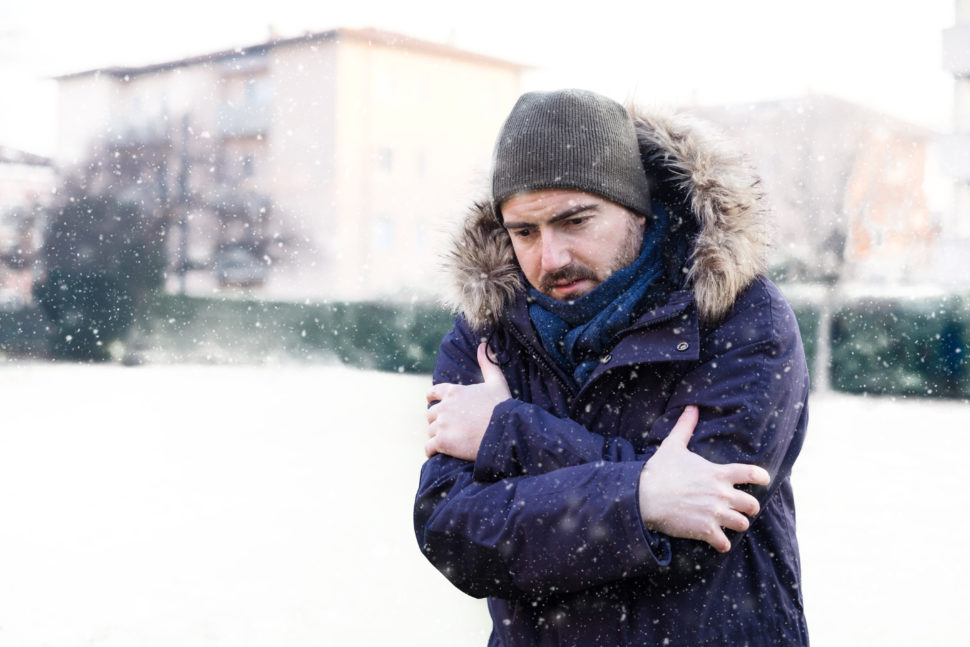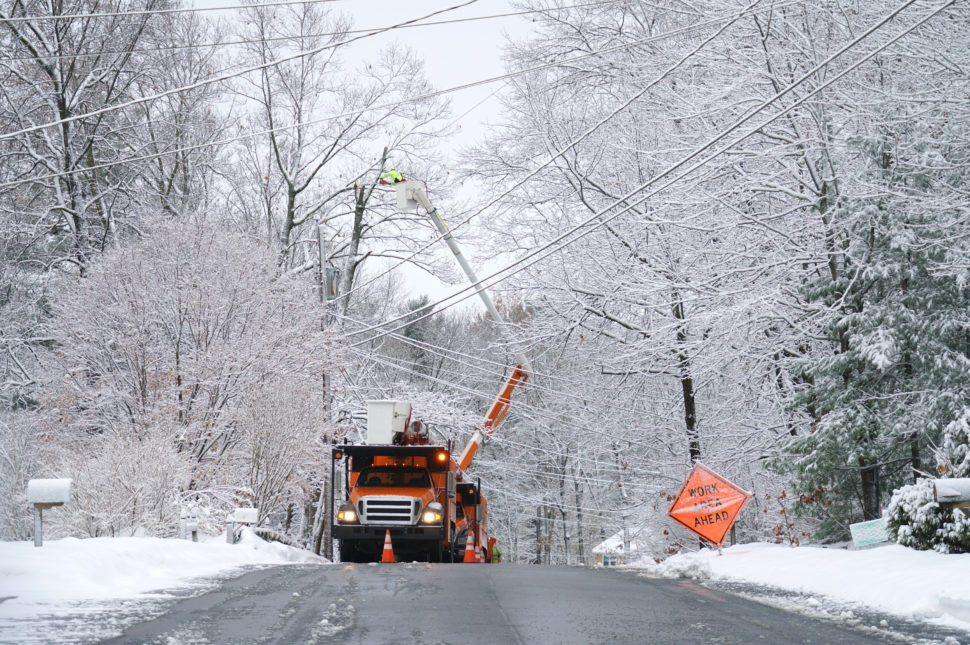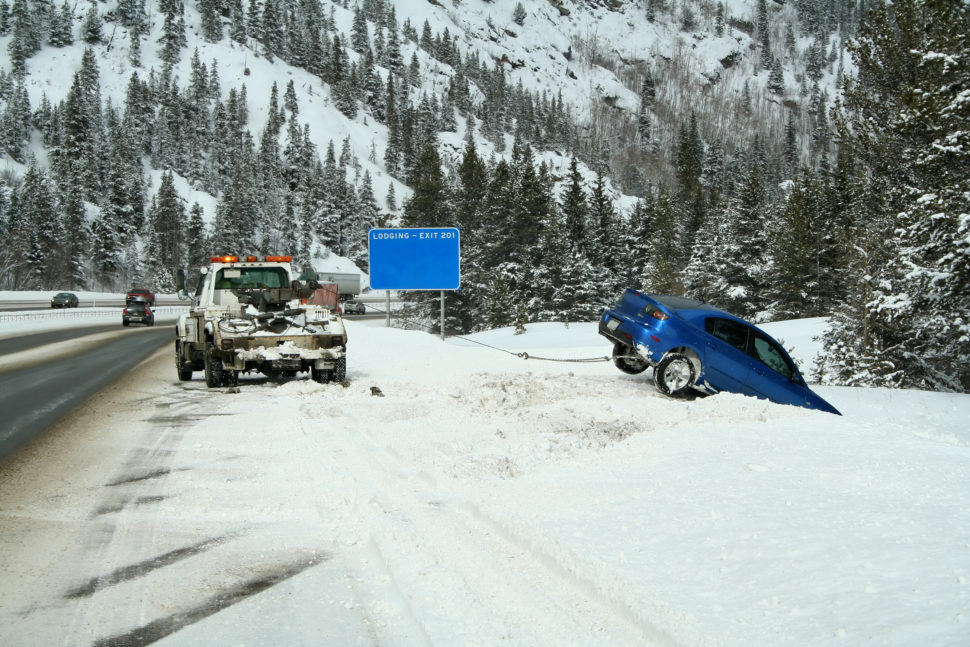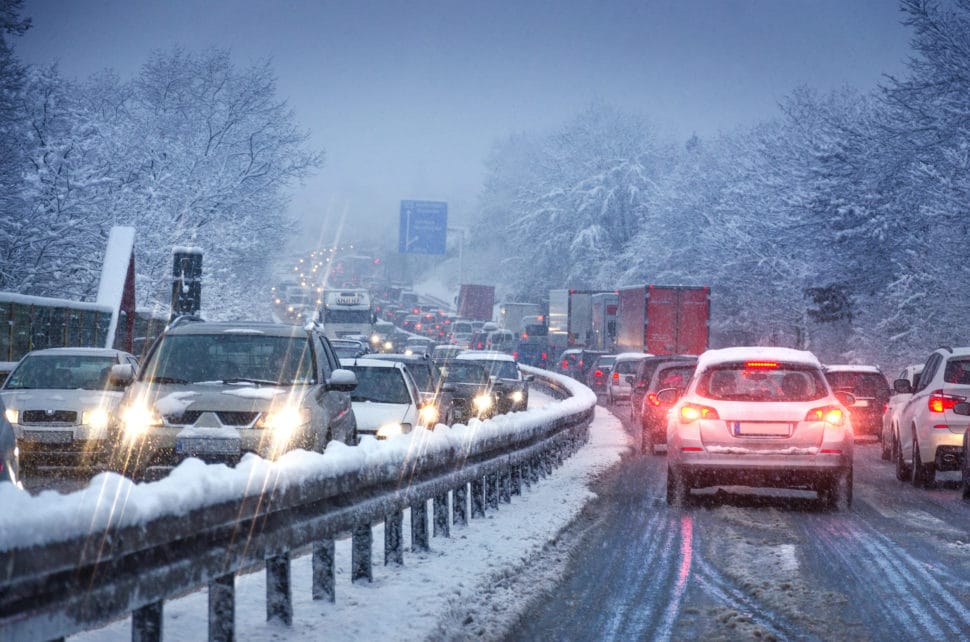As we approach the winter months, it is important for employers to be aware of dangers that are possible on their job site now that may not be as much of a concern the rest of the year.
Across most of the United States, with just a few exceptions, the cold is an obvious danger. But there are several other dangers beyond low temperatures that workers should keep in mind heading into the winter season.
Cold Temperatures Create Their Own Hazards
The winter of 2019-20 ended up as the second-warmest on record, and current forecasts show this upcoming winter should be fairly similar. However, winter weather hazards don’t disappear when temperatures seem to be warmer. In fact, dangers specific to the cold may be even more dangerous then as workers can be caught off guard.
If you are outside for any extended period of time during winter, it is important to pay attention to the wind chill, which takes into account both the air temperature and the wind speed. Normally, your body radiates enough heat to create a warm barrier that keeps your body temperature around 98.6°F (37°C). In cold, windy conditions, that insulating barrier is broken up.

Many people do not realize that hypothermia technically starts once the core body temperature drops below 95°F (35°C). While below-freezing temperatures are an obvious cause of hypothermia, you must also be mindful of a wind chill that might not seem as dangerous at the outset.
Signs and symptoms vary based on the degree of hypothermia but it typically begins with shivering, an increased heart rate and rapid breathing. With moderate hypothermia, symptoms start to include slurred speech, confusion and drowsiness.
Pulse and respiration rates drop significantly in severe hypothermia, and the person may experience hallucinations or a loss of consciousness, and shivering is often absent at this stage. If you suspect someone you are with may be showing any symptoms of hypothermia, call 911 and try to keep the victim warm and dry while help arrives.
One of the most common, but underestimated, winter dangers is frostbite, which is simply the freezing of the skin, typically the fingers, toes, nose, ears or cheeks. Frostbite occurs in three phases:
- Frostnip causes skin redness and some numbness, with no permanent damage
- Superficial frostbite starts as reddened skin that turns white, and may result in fluid-filled blisters 12-36 hours after rewarming the skin
- Deep frostbite affects all layers of the skin and could result in loss of joint or muscle functionality
There are many preventive measures you can take to avoid frostnip or frostbite, including limiting your exposure to cold, wet and windy conditions, wearing several layers of loose clothing, fully covering your head and ears, and staying hydrated both before and while you are outside.
Winter Weather Brings Several Dangers
Just as in the spring and summer when thunderstorms can create many different types of safety hazards, winter storms bring their own varieties of danger. No matter where you live and work, it is important to be winter weather aware because even the warmest parts of the country can experience strange weather occurrences.
Blizzards
More than just heavy snow, the biggest hazards of a blizzard are created by the sustained winds (at least 35 mph) and low visibility (less than 1/4 of a mile). In fact, falling snow isn’t even necessary to create blizzard-like conditions; high winds can create a “ground blizzard” from snow that has already fallen.
Ice Storms
Just as the name suggests, these storms result in an accumulation of at least 1/4” of ice. This may not sound like very much, but ice creates numerous hazards, from slick streets and sidewalks to damaged trees and powerlines.

Lake Effect Storms
This winter danger is common across the Great Lakes region and occurs when cold, dry air from Canada passes over the Great Lakes, picking up an abundance of water. The resulting snow gets dumped to the south and east of the lakes, creating quick, heavy snowfall.
Snow Squalls
A squall in general is a sudden violent wind, which, in the winter, is accompanied by snow. A snow squall can be thought of similar to a summertime thunderstorm, but instead of small bursts of heavy rainfall you will get heavy snowfall. These storms are also most commonly found in the Great Lakes region.
While these are the major storm types that often occur during the winter, it can also be helpful to understand the different types of wintry precipitation you might encounter.
Snow
Most winter precipitation starts out as snow, but the temperatures throughout the Earth’s atmospheric layers determine what type of precipitation we get on the ground. When all of those layers are at or below 32°F (0°C), we end up with snow.
Sleet
When snow hits a patch of above-freezing air and is able to partially melt, only to fall through another layer of air that is at or below freezing, the end result is sleet. Depending on how much the precipitation is able to thaw and refreeze, these frozen raindrops can accumulate on the ground much like snow.
Freezing Rain
This type of precipitation is similar to sleet, except these droplets are able to completely melt before reaching another cold layer. Because the final blast of cold air isn’t enough to refreeze the rain, the droplets instead instantly refreeze upon contact with anything at or below freezing, like the ground, trees or power lines.
Rain
If the atmosphere and ground are above freezing, what started as snow hits the ground as rain. However, if the ground temperature falls below freezing, the rain can quickly become ice, creating slick and dangerous conditions.
Winter Driving Safety
One wintry weather hazard that can affect people across the country is dangerous driving conditions. In fact, more than 20% of annual vehicle crashes are weather related. Slick and wet roads create many problems for drivers, including loss of traction or maneuverability, diminished visibility and road obstructions.
Whether your employees drive as part of their job or they are simply commuting to and from work, it is important that everyone stay weather aware, understand unsafe driving conditions and be prepared in case of an accident or getting otherwise stranded.
Before winter weather hits, everyone should have a trained professional inspect the vehicle and check for:

- Even and balanced braking on all tires
- A proper mixture of antifreeze and water in the cooling system
- Battery charge, ignition timing and alternator belt condition
- Exhaust leaks
- Tread, inflation and wear of tires
- All fluid levels, such as brake fluid and engine oil
- Functionality of exterior lights, defrosters and windshield wipers
The U.S. Department of Transportation (DOT) recommends that all drivers put together an emergency vehicle kit in case you, or anyone else on the road, gets stuck in a dangerous situation.
Some of the items they suggest to include are:
- Blankets and a change of warm clothes
- Flashlights and extra batteries
- Jumper cables
- Ice scraper and snow brush
- Emergency flares
- Snacks and bottled water
- Any medication you take
- Road maps for your area
- Traction aids, such as bags or sand or kitty litter
- A bright cloth or other sign to alert passers-by that you need assistance
Now that you know how to prepare before heading out on the road, what do you do if you get stranded due to ice, snow or other winter weather hazard? Most importantly, you should remain in your vehicle unless help is visible and easily accessible.
Call for emergency assistance but be aware that response times may be slow in severe conditions. If you become stranded during work hours, notify your supervisor if your situation. If you are stranded outside of working hours, be sure to notify a friend or family member and include your location so that your whereabouts are known.
If you can safely exit the vehicle, do so only to hang your cloth or other sign from the radio antenna. You should also make sure your exhaust pipe is clear of snow to prevent carbon monoxide poisoning, then immediately get back in your vehicle.
Do not leave your car running as this may result in a dead battery. Instead, turn the car on for about 10 minutes every hour and run the heat to keep warm. Clap or rub your hands together regularly, and be sure to move your arms and legs as much as possible. Movement helps maintain good blood circulation and will help prevent frostbite or hypothermia.
Be Aware of Walking Hazards
If your workplace is open during the winter, either to employees only or also to customers and other guests, it is important to do what you can to ensure a safe environment in and around the building.
Slips, trips and falls are a top hazard any time of year, but the risk is even higher when snow and ice can create slippery surfaces on sidewalks, parking lots and other outdoor walkways. Additionally, rain and wet snow can cause indoor surfaces to be slick and dangerous as people enter the building.
If you know employees, customers or visitors will be coming to your building or worksite, it is smart to clear all paths of snow and ice and use a deicer to help keep the area slip-free. When possible, blowing away any snow that accumulates near the walking paths can also maintain a clear area.
Workers should be aware of the proper types of shoes to wear in the snow or ice. A pair of insulated boots with good rubber treads is a must for walking during or after a winter storm. Keeping a proper pair of shoes in your vehicle may be helpful in case walking conditions are different at home versus at the worksite.
Employers may want to invest in absorbent rubber mats to use at all entrances for workers and guests to wipe their feet on. Placing “Wet Floor” signs around the building will also remind everyone to use caution.
Looking for more online safety training content?
Preparing for Cold and Flu Season

We have likely all heard of, and probably even experienced, an increase in colds and other illnesses during the winter months. While the old adage of this being an effect of cold, wet weather isn’t entirely accurate, it is true that you are more likely to get sick when it is colder outside.
When temperatures drop, people tend to stay inside more. Close-quarters interactions with coworkers, family members or roommates naturally result in more face-to-face contact, increasing the spread of a transmissible virus.
Of course, there are things you can do to protect yourself and others from catching, or spreading, illnesses:
- Avoid close contact with others when possible, especially if you have any symptoms
- Wash your hands with soap and warm water, scrubbing for at least 20 seconds
- Cough and sneeze into a tissue and throw it away, or cough and sneeze into your upper shirt sleeve
- Try to avoid touching your eyes, nose or mouth
- Disinfect frequently used items, such as doorknobs, lightswitches, phones and computer keyboards
Remember, these tips will help stop the spread of both the common cold and the flu, but it is important to understand the differences between the two, as the flu can result in more serious health complications.
This season, everyone will need to be especially mindful as there are many similarities between the flu and COVID-19, commonly called the coronavirus. As much of the country has become accustomed to since early 2020, it is recommended people continue to maintain social distance and wear a mask or face cover when around others.
Don’t Neglect Mental Health
Oftentimes, people find themselves getting a bit lazy or even feeling a little more sad during the cold and dark winter months. But these feelings shouldn’t be brushed aside and both employees and employers should watch for signs of this form of depression.
Seasonal affective disorder (SAD) is a type of depression that comes and goes in a seasonal pattern. Some people with SAD may be affected during the summer, but most affliction begins in the fall and continues, or worsens, in the winter.
While the exact cause of seasonal affective disorder is still not fully understood, there are a few factors believed to come into play:
- Production of melatonin: The changing seasons can disrupt the body’s level of this hormone that regulates the sleep cycle
- Production of serotonin: Reduced sunlight can cause a drop in this brain chemical that contributes to happiness
- Circadian rhythm: A decrease in sunlight can also throw off our internal clock, as sunlight is used to time various functions, such as waking up
Some people dealing with seasonal affective disorder may want to see their doctor if they cannot overcome symptoms for days at a time. However, in many cases, getting outside for natural light throughout the day, partaking in regular exercise or utilizing a special lamp that simulates sunlight can be enough to help people out of these “winter blues.”
As an employer, it is important to understand that the winter months can be more difficult for some people and to recognize when employees may need a bit of a break — mentally or physically.
Make sure your employees know what options are available to them. Some things you may consider implementing include:
- Allowing quick 10-minute breaks to get away from their desks
- Keeping work at work whenever possible to maintain a good work-life balance
- Utilizing insurance or employee assistance programs (EAPs) to access counseling resources
- Encouraging employees to take mental health days if things get overwhelming

Some of these suggestions may not work for your workplace, and that’s okay. Take into account the kind of work you do and the industry you’re in, and create options that will best suit your needs.
The bottom line is that employees need to know they are appreciated as workers and cared for as people. Making it easy, and acceptable, to make even the smallest of concessions in support of strong mental health is likely to encourage your employees to stay with you longer.
Taking Control of Safety
While understanding general winter hazards is important, it is crucial that you and all your employees recognize the specific dangers that may arise at your jobsite.
One step you need to take is reviewing the physical settings of your work area. Do you work outdoors where low temperatures and weather will play a big factor in employee safety? Are your workers driving long distances on the job? By examining the physical and environmental settings of your work, you can discover potential dangers to consider and prepare for.
A large part of occupational health and safety (OHS) has typically been how an employee recognizes hazards and responds to workplace accidents. But in the last few years, the field has evolved to become more about prevention and hazard identification.
OHS experts have started focusing on educating employees and identifying potential issues rather than on what is essentially damage control. The hope is that taking a prevention-based approach and trying to stop an accident from ever happening will help companies save the time and money that comes along with mitigating the effects of workplace accidents.
A job hazard analysis (JHA), sometimes called a job safety analysis, task hazard analysis or job hazard breakdown, is one way for your company to identify and work to correct potential dangers in your specific workplace.
Conducting a JHA will help you understand the most dangerous jobs in your workplace, what those specific hazards entail, and corrective and preventive measures you can take to reduce or completely eliminate the likelihood of accidents, injuries and illnesses.
Keeping Everyone Safe
So now that you have an idea of some of the basic winter hazards you need to be aware of, how do you go about keeping your employees safe?
Taking online safety training is convenient as each of your employees can receive training on a wide range of topics, from avoiding cold stress to understanding specific OSHA regulations.
Another benefit to taking training online is how easy it is to repeat training as often as is needed — or as often as you would like. Some OSHA regulations require training to be conducted at least annually, but because you never know when an inspection could occur, it is never a bad idea to brush up on safety training even when not required.
It’s never a wrong time to evaluate your current safety program, or implement a new one, to protect your employees. Contact SafetySkills today to see how we can help you get started on improving your safety program.


